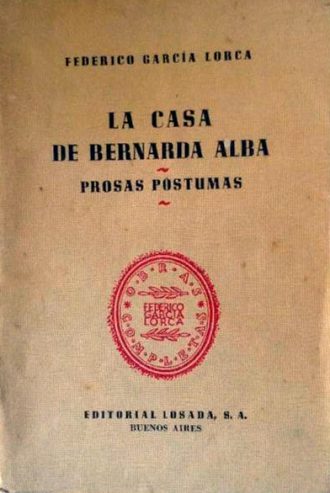
The House of Bernarda Alba (La casa de Bernarda Alba). A drama of women in the villages of Spain that begins with the funeral of Bernarda Alba’s second husband. After the parade of neighbors who have come to her house to pay their condolences, Bernarda announces to her daughters (the youngest, 20 years old, and the oldest, 39 . All unmarried) an eight-year mourning. Only Angustias, the firstborn and the only daughter of her first husband (the only heiress, therefore), was to be engaged to Pepe el Romano.
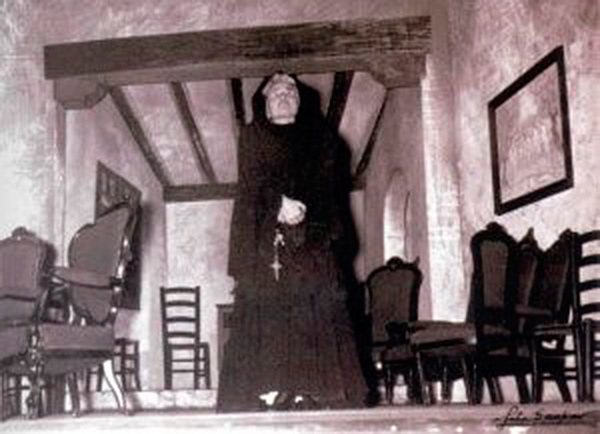
Soon a silent battle begins between Angustias, Adela (who had become Romano’s lover) and Martirio for the young man, while they weave, in a suffocating heat, some clothes that none of them is sure to wear. When Bernarda becomes aware of her youngest daughter’s relationship with Pepe, an argument breaks out in which Adela confronts her mother with the truth, breaking her cane. Bernarda asks for a gun and goes out to shoot Pepe el Romano.
After hearing the shot, Adela believes her lover is dead and hangs herself. At the end of the play, Bernarda swears that she will finish Pepe off, reveals that Adela, her youngest daughter, died a virgin to keep up appearances, and orders silence, as in the beginning of the play.
It premiered in Buenos Aires on March 8, 1945, at the Avenida Theater, on the initiative of Margarita Xirgu. Performers: Margarita Xirgu (Bernarda Alba), Antonia Herrero (Mª Josefa), Teresa Serrador (Angustias), Carmen Caballero (Magdalena), Teresa Pradas (Amelia), Pilar Muñoz (Martirio), Isabel Pradas (Adela), María Gámez (La Poncia), Luz Barrialo (maid), Emilia Milán (Prudencia), Teresa León (Beggar), Susana N. López (1st woman), Aída Espí (2nd woman), María López Silva (3rd woman), Emilia López (4th woman) and Susana Canales (Girl). Santiago Ontañón designs the sets, organizes the rehearsals and takes care of all the details.
Also in Buenos Aires, in that same year, the first edition of the play appeared in Losada, from an apograph provided by Margarita Xirgu after Julio Fuensalida sent it to her. It was not until 1981 that a text was published in Spain, in the Alianza Publishing House, based on an autograph preserved at the Federico García Lorca Foundation. Mario Hernández edited it.
It seems that it was the manuscript that the author always carried with him, on which he worked while he was a refugee in the house of the Rosales family and that was kept hidden in a haystack to protect it from the records of the time. The differences between both texts are only orthographic signs, a change of order in some expressions or substitutions of some terms for others. The autograph seems to have been corrected by the author after the creation of the apograph.
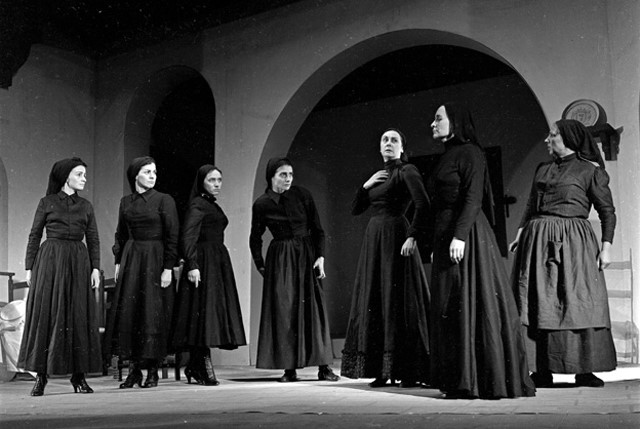
In Spain, it was very difficult for people to be able to read it due to the censorship imposed by the Franco regime. It premiered at the Teatro de Ensayo La Carátula in Madrid in 1950. Performers: Amparo Reyes (Bernarda Alba), Antonia Herrero (Mª Josefa), Lola Gaos, Maruja Recio, Berta Riaza, Carmen Ferreira, María Luisa Romero, Consuelo Muñoz. Set design by Enrique Ribas. According to the press release by ABC (Wednesday, March 22, 1950, p. 21), “it was a resounding success. The select audience that attended this performance in the beautiful hall of the P.M.M., listened to the play with moved interest and, at the end of each act, gave a standing ovation, while the curtains were repeatedly drawn.”
Premiere in other languages: Théâtre des Champs-Elysées, Paris, 1945. La Maison de Bernarda Alba. Direction: Maurice Jacquemont. Cast: Madeleine Barbulée, Marthe Mellot, Silvia Monfort (Madeleine), Liliane Maigné, Odette Talazac, Germaine Michel, Jeanne Hardeyn, Annie Cariel.
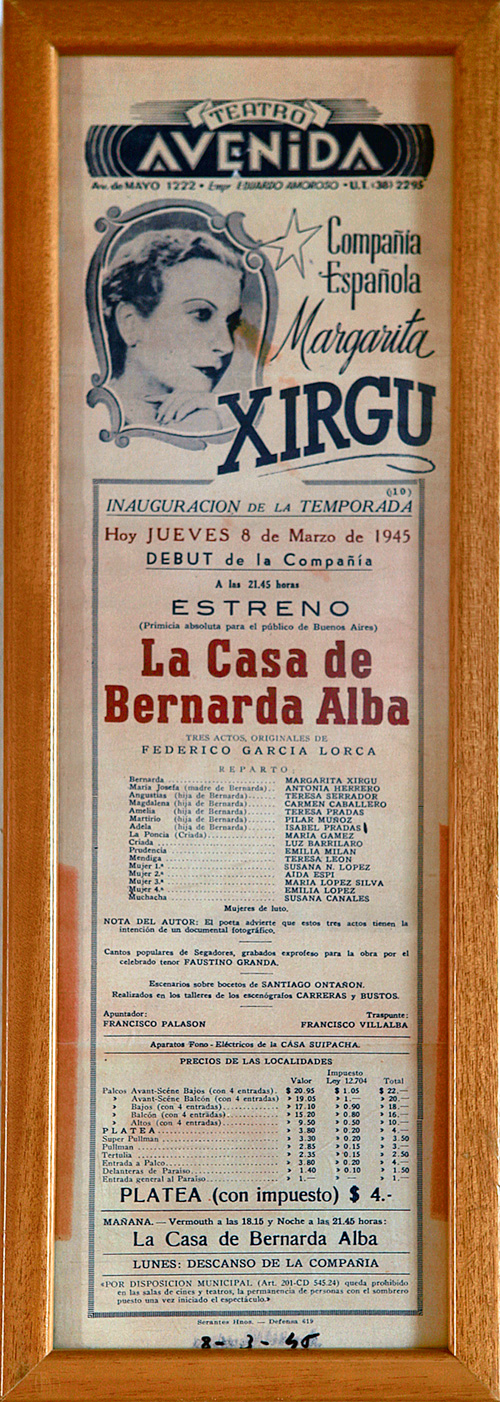
When Federico’s family arrived in Valderrubio, then Asquerosa (Disgusting), they lived for a short period of time in Ancha Street, today called Calle Real, opposite the house of Frasquita Alba. Later they were to move to Calle de la Iglesia, number 20, to a large farmhouse, today House-Museum of the poet.
La Casa de Bernarda Alba (The House of Bernarda Alba) is entirely inspired by this village in the Vega of Granada, Asquerosa (Disgusting) (currently, Valderrubio). Although the inhabitants changed the unpleasant name (Federico preferred to use Vega de Zujaira to locate his writings), this has nothing to do with the etymology of ‘asqueroso’, but derives from acqua rosa.
Lorca collects in his drama the way its people speak, their idioms, their customs (the long mourning, the surveillance of the neighbors, the scandals that occurred for sexual matters, the arrival of the reapers in summer, the heat…). This work shows and denounces the conditions that still existed in the Spanish countryside, and the power and abuse of the landowners. (the Federico’s father was the only one who had a different way of doing things, more supportive and more humane, in fact, in the village there is still a street named after him, Don Federico), the prevailing depotism…
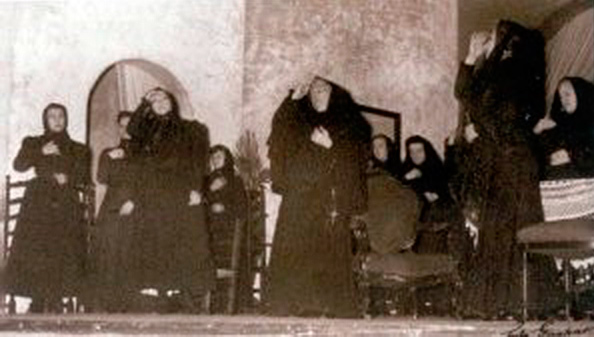
In the end, when Adela breaks Bernarda’s cane, it becomes a truly revolutionary moment. Adela rejects a code of honor based on keeping up appearances and the belief that men are superior to women; she claims her sexual freedom and the search for love as salvation above any social norm or any authority.
It was necessary to wait until 1996 to see the play premiered in Valderrubio where, since it was inspired in part by authentic characters, it weighed on the taboo. In fact, the poet’s mother asked him to change its name to Frasquita (Frankie), precisely to prevent it from being so badly received.
News of the purchase and restoration of the house that inspired The House of Bernarda Alba (El País).
Performance of The House of Bernarda Alba. National Drama Center. (Complete)